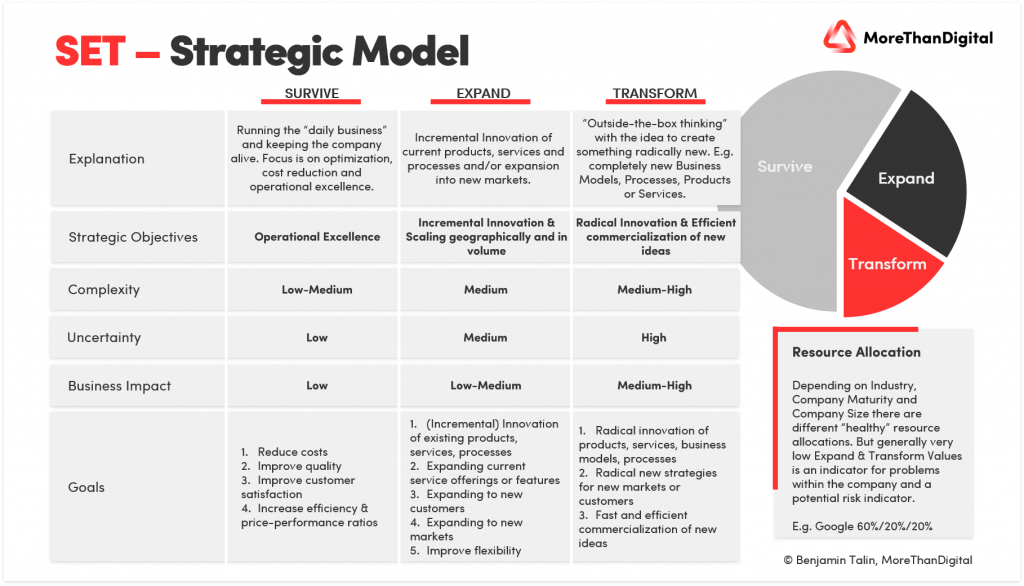SET Model for strategic business planning
We all know the struggles in defining strategies for companies. But what if I told you that three numbers define your business strategy, your future-readiness, and your company culture?
When we talk about a strategy, we must include all possibilities for expansion and transformation. The SET Model helps by analysing the three strategic investments of your company: Survive, Expand and Transform.
What are the Resources in the SET-Model?
The SET Model uses every resource a company has as a basis. The easiest resource to track and analyse is your budget. When it comes to your company’s identity and goals, budgets do not represent the complete picture. Holistically, resource distribution should occur across distinct aspects of the company’s operations. Investments, costs, employee hours, management attention, role adoption, and education are some of the best-known examples.
When we talk about resource allocation within the SET Model, we also mean measuring all aspects of your business resources.
The Three Stages in the SET-Model Explained

Survive
Operational Excellence, reducing costs, improving quality, improving customer satisfaction, and increasing overall efficiency are the main goals to follow. Thus, you end up getting the best price-performance ratio for your company.
The “Survive” phase represents every investment, every resource dedicated to your “daily business” and keeping it alive. Although this process encompasses everything related to costs, like production, wages, rent, and other expenses, it also involves sales and administration.
The projects involved in the Survive area are typically low in complexity, uncertainty, and business impact. Apart from the apparent cost reduction, the “Survive” stage is also about improving and is tightly related to customer satisfaction.
Expand
Incremental Innovation & Scaling geographically and in a volume are the main objectives for Expand investments. Projects involved have average complexity and levels of uncertainty.
Typically, during the Expand phase, most efforts go toward improving products and services, upgrading their features, and prepping them for eventual introduction to new markets. The expansion is a two-prong mission: you expand your product or product line, but you also seek new grounds where these enhanced items are likely to attract first-time customers.
Transform
The Transform phase gives you the freedom you need for Radical Innovation & Efficient commercialization of present ideas. New business models, radically new products, and services but also processes are central to this phase.
It is worth noting that the outcome of the third stage of the SET Model is uncertain and has a high difficulty level. Consequently, the elevated risk and complexity involved in Transform naturally make your business prone to withstanding unexpected blows or radical change of perspective.
Having higher investments in this area is mostly also correlated with market leaders. Innovative companies that set an example for their industry peers, typically invest more in new products, services, and strategies for market entries. The transform phase is about the fast and efficient commercialization of fresh business ideas.
Resource Allocation
One of the big questions is the “golden rule” when it comes to resource allocation. Unfortunately, no set figure is either good or bad. It always depends on the industry, the company strategy but also on its position in the market. The faster the industry moves, the more market entries there are. Moreover, the higher the chance for potential disruptions, the more business resources go toward the “Expand” and the “Transform” phases.
Google sets a clear example of this tendency. They follow the 60/20/20 rule for resource allocation, and this directly affects many of their employees. One of the more prominent rules is the “20-Percent Rule” where employees can dedicate a fifth of their work hours to do whatever they think is best for the company.
SET Model as Analysis Tool for Culture and Future-Readiness
The SET Model is versatile: you can use it for strategy workshops and resource planning and analyse your current company status. The lower the investments in “Expand” and “Transform,” the more risk associated with the company. It means that only a tiny fraction of the company works towards the future, and this discrepancy of resource allocation reflects on the company‘s culture. And we know that company’s culture is a vital factor in the quest for digital transformation.
Avant-garde project investments can bring insights about the innovation culture, optimal hiring patterns, and external attractiveness for innovative new team members.
Conclusion on the SET-Model
When we do evaluate the state of a company, we must avoid over-simplifying it. The SET Model brings some powerful insights into the industry standards and variables, and it is an easy-access powerful strategic tool.
Additionally, it is wise to ask yourself if you want your company to be a market leader or a follower. The strategic implications of this choice reflect on the efficiency of your resource allocation. If you consider yourself more of a leader than a follower, you should invest more in the “Expand” phase, especially the “Transform”. Leaders are used to taking risks and going “against the grain” and embrace innovative strategies. In contrast, followers walk on a paved path and consider going into the unknown as too risky. The SET model will help you define the leader/follower ratio for your company.
SET Model is great for uncovering potential issues within a company, especially those that allude to their primary strategists. Getting a company future-ready is a challenge reserved for those who can set a bright example that others would adopt as their own. Many market entries depend on the moves of industry leaders.
Even the business veterans channel more than half of their human and material resources towards keeping their company afloat. They split the rest equally between their existing products and the development of innovative ideas.
The SET model has a clear formula embedded in its philosophy: as soon as you become comfortable in your business environment (Survive), it is time to look up and maximize your growth potential (Expand), and then dare explore your alternative options (Transform).

